
White Sturgeon
Acipenser transmontanus
The White Sturgeon (Acipenser transmontanus) is a remarkable and ancient fish species, known as the largest freshwater fish in North America. This prehistoric creature can be found primarily in the river systems along the Pacific coast, ranging from Alaska to Central California. Recognizable for its elongated, torpedo-shaped body and distinctive bony scutes instead of scales, the White Sturgeon has a grayish to brown complexion with a pale underbelly.
A true giant of the aquatic world, these sturgeons can grow to impressive lengths of up to 20 feet and weigh over 1,500 pounds, although individuals of such immense size are increasingly rare due to overfishing and habitat loss. They have a life span that can exceed 100 years, contributing to their status as living fossils, virtually unchanged since the era of dinosaurs.
White Sturgeons have a unique feeding habit, relying on tactile and electroreception senses to detect prey in the murky riverbeds. Their diet comprises a variety of bottom-dwelling organisms, including crustaceans, small fish, and invertebrates. As an anadromous species, they migrate between saltwater and freshwater, utilizing estuarine environments during different life stages. Conservation efforts are in place to protect this incredible species, which has historically faced threats from caviar harvesting and environmental disruptions.

 All Species & Breeds
All Species & Breeds
 Highland Cattle
Highland Cattle
 Miniature Donkeys
Miniature Donkeys
 All Species Directory
All Species Directory
 Highland Cattle in Virginia
Highland Cattle in Virginia
 Miniature Donkeys in Texas
Miniature Donkeys in Texas












